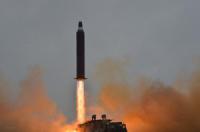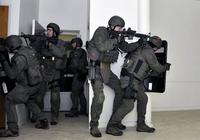-
The worry over North Korea

The risk of war on the Korean peninsula is low, says a nuclear arms expert. “Both sides are rattling sabers, but neither side is going to start a war,” says Belfer Center’s Gary Samore. “We recognize that a military attack on North Korea would probably not be effective in terms of destroying North Korea’s nuclear weapons and missile program and would run the risk of a North Korean retaliation against South Korea and Japan, which could cost hundreds of thousands of lives. And the North Koreans know that any attack on U.S. allies in the region would provoke an American response that would destroy them.”
-
-
Declassifying rescued nuclear test films
The United States conducted 210 atmospheric nuclear tests between 1945 and 1962, with multiple cameras capturing each event at around 2,400 frames per second. But in the decades since, around 10,000 of these films sat idle, scattered across the country in high-security vaults. Not only were they gathering dust, the film material itself was slowly decomposing, bringing the data they contained to the brink of being lost forever. For the past five years, physicists, film experts, archivists, and software developers have been on a mission to hunt down, scan, reanalyze, and declassify these decomposing films. The goals are to preserve the films’ content before it is lost forever, and provide better data to the post-testing-era scientists.
-
-
White House: Uranium discovered by IAEA likely tied to Iran’s nuclear weapons program

Obama administration officials concluded that particles of uranium found at Iran’s Parchin military base and revealed in the International Atomic Energy Agency’s final report on the country’s past nuclear activities were likely tied to the regime’s nuclear weapons program. The admission further underscores concerns that the IAEA’s investigation into Iran’s nuclear activities at Parchin should not have been closed following the report’s publication.
-
-
It is 3 minutes to midnight -- still

The Bulletin of the Atomic Scientists yesterday announced that the minute hand of the Bulletin’s closely watched Doomsday Clock will remain at three minutes to midnight, since recent progress in the Iran nuclear agreement and the Paris climate accord “constitute only small bright spots in a darker world situation full of potential for catastrophe.” The Bulletin’s panel of security experts said that “Three minutes (to midnight) is too close. Far too close…” – but that this reflects “world leaders continue to fail to focus their efforts and the world’s attention on reducing the extreme danger posed by nuclear weapons and climate change. When we call these dangers existential, that is exactly what we mean: They threaten the very existence of civilization and therefore should be the first order of business for leaders who care about their constituents and their countries.”
-
-
ISIS “trying to obtain chemical, nuclear weapons”: U.K. government
British prime minister David Cameron said yesterday that the government security review has warned that ISIS and al-Qaeda are trying to get their hands on chemical and nuclear weapons. Cameroon referred to the security review in a speech in which he called on Members of Parliament to approve U.K. air strikes in Syria within a week. The British government pledged allocation additional resources for new equipment and the creation of within the Army of two new rapid response “strike brigades” of 5,000 soldiers each. The number of civilian jobs in the Ministry of defense, though, will be heavily reduced.
-
-
Los Alamos lab admits mishandling toxic waste, causing repository radiation leak
In a letter addressed to the New Mexico Environment Department (NMED), lab officials at Los Alamos National Laboratory (LANL) have admitted to mishandling toxic waste shipped to the Waste Isolation Pilot Plant (WIPP) in Carlsbad, New Mexico, the nation’s only permanent repository for plutonium-contaminated waste from government nuclear facilities.
-
-
Mustard plants help detect use of chemical weapons
Making nations comply with the Chemical Weapons Convention requires that scientists can accurately detect the use of chemical warfare agents. Currently they carry out tests on soil from areas where use is suspected. Many nerve agents composed of organo-phosophorous compounds, however, leach from soil over time, removing the evidence of use and making verifying the deployment of chemical weapons like sarin, soman, and VX difficult. Researchers report that white mustard plants can help by allowing detection for up to forty-five days after the chemical weapons were used.
-
-
First full-system mechanical environment test of B61-12 nuke completed successfully
The U.S. National Nuclear Security Administration (NNSA) announced the successful completion of the first full-system mechanical environment test of the B61‑12 as part of the NNSA’s effort to refurbish the B61 nuclear bomb. This first full-system mechanical environment test is one of several critical milestones for the B61-12 Life Extension Program (LEP). The B61-12 will replace the existing B61-3, -4, -7, and -10 bombs. Fielding the B61-12 will also enable the retirement of the B83, the last U.S. megaton class weapon, in the mid-to-late 2020s.
-
-
B61-11 earth-penetrating weapon tested for first time in seven years
One of the main purposes of the U.S. nuclear stockpile is deterrence, and one important way to assure deterrence is to have a successful surveillance test that shows that the systems in the stockpile work. Sandia’s annual surveillance program for each weapon type consists of flight tests, lab tests, and component and material tests. On 20 November 2013, researchers conducted a rocket-driven impact test of the nonnuclear components of the B61-11 earth-penetrating weapon, the first such test in seven years. Flight tests subject the weapon to shock, vibration, temperature, rotation, weather, and more. Sandia pulls random units from the stockpile for tests.
-
-
DHS: conspiracy theories about DHS purchases unequivocally false

Conspiracy theorists have pointed to several DHS solicitations for gear and ammunition as “proof” that the department is in the process of creating, training, and equipping a secret force, the purpose of which would be to suppress public dissent – or worse: one blogger wrote that “Another possible conclusion [regarding DHS’s ammo purchases] is that the bullets are intended to coerce and, if need be, kill us.” DHS flatly rejects these conspiratorial assertions as unequivocally false, saying that each and every purchase is in line with past purchases and in support of on-going, legitimate, and transparent departmental operations.
-
-
Number of U.S. drone strikes in Pakistan, Yemen significantly reduced
In the past several months, the United States has reduced the number of drone strikes on terrorist targets in Pakistan and Yemen. The United States launched 117 drone strikes in Pakistan in 2010, compared to twenty-one so far this year. Representative Mike Rogers (R-Michigan), chairman of the House Permanent Select Committee on Intelligence, is concerned. “[The threat of terrorism is] not diminishing,” he said. “There have been counterterrorism changes made by the administration that have concerned us all, things that we’ve been working on for a period of months that we’re trying to work through that are very, very concerning. This is no time to retreat.”
-
-
Powerful stun guns popular in U.K.

Possessing a stun gun in the United Kingdom can carry a jail sentence of ten years, but the police keep seizing hundreds of stun guns every year; U.K. law enforcement agencies have investigated more than 200 crimes in the last three years involving stun guns, and that in those three years almost 500 stun guns have been seized by police
-
-
Less-lethal 12-gauge shotgun round for law enforcement unveiled
Innovative new round flattens, or “pancakes,” across a subject’s body on impact rather than keeping its shape as other rounds do
-
-
Better to use spray rather than a gun in bear encounters
Carrying a gun in bear country does not mean you are more protected in the event of a bear encounter; researchers say people should behave cautiously and carry bear spray instead
-
-
The Bruzer – a less lethal, compact 12-gauge
To augment local police officers’ growing array of non-lethal weapons, Tommy Teach, a military combat veteran, has designed a compact non-lethal 12-guage shotgun
-
- All
- Regional
- Water
- Biometrics
- Borders/Immig
- Business
- Cybersecurity
- Detection
- Disasters
- Government
- Infrastructure
- International
- Public health
- Public Safety
- Communication interoperabillity
- Emergency services
- Emergency medical services
- Fire
- First response
- IEDs
- Law Enforcement
- Law Enforcement Technology
- Military technology
- Nonlethal weapons
- Nuclear weapons
- Personal protection equipment
- Police
- Notification /alert systems
- Situational awareness
- Weapons systems
- Sci-Tech
- Sector Reports
- Surveillance
- Transportation
Advertising & Marketing: advertise@newswirepubs.com
Editorial: editor@newswirepubs.com
General: info@newswirepubs.com
2010-2011 © News Wire Publications, LLC News Wire Publications, LLC
220 Old Country Road | Suite 200 | Mineola | New York | 11501
Permissions and Policies
Editorial: editor@newswirepubs.com
General: info@newswirepubs.com
2010-2011 © News Wire Publications, LLC News Wire Publications, LLC
220 Old Country Road | Suite 200 | Mineola | New York | 11501
Permissions and Policies
